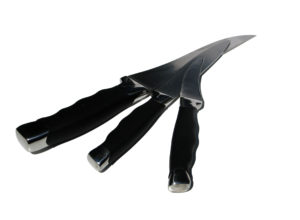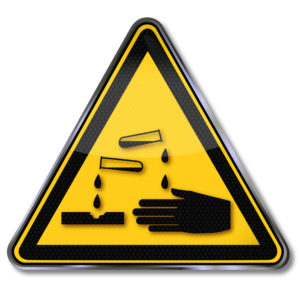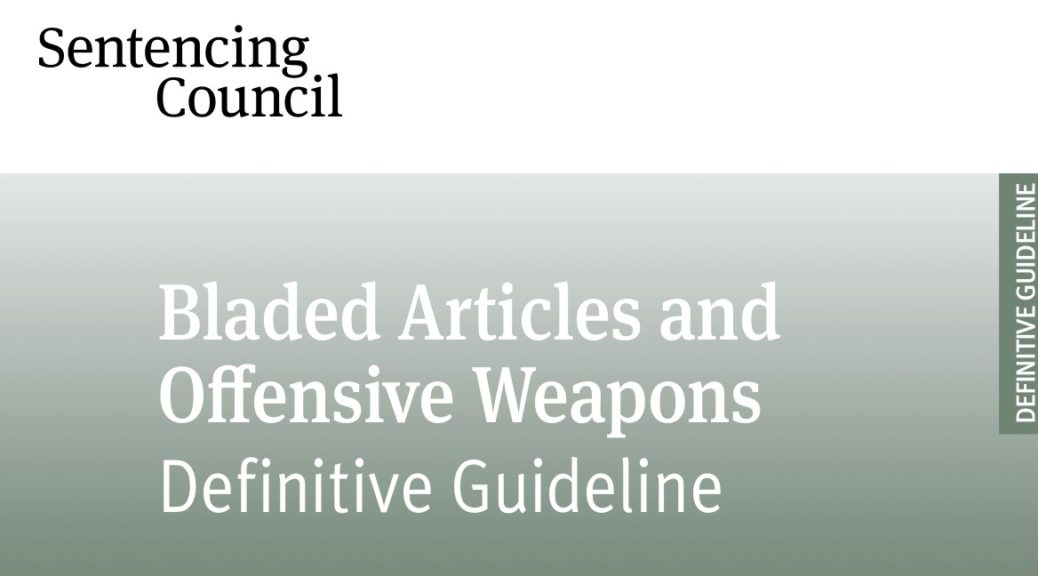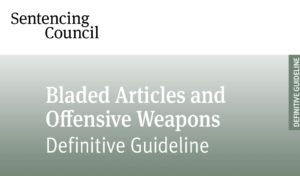Knife crime is very much on the political agenda, with a number of stabbings having taken place over the last few weeks. These incidents resulted in death or serious injury. In due course there will be a significant prison sentence for those found responsible.
Attention is now focused on using deterrent sentences to discourage knife possession.
Knew sentencing guideline for knife crime
The Sentencing Council, which is responsible for setting sentencing guidelines in England and Wales, has today issued a new guideline for knife crime offences.
The guideline will apply to all of those sentenced on or after 1 June 2018, regardless of the date of the offence.
What offences does it cover?
The guideline applies to offences of:
- Possession of an offensive weapon in a public place
- Possession of an article with a blade/ point in a public place
- Possession of an offensive weapon on school premises
- Possession of an article with a blade/ point on school premises
- Unauthorised possession in prison of a knife or offensive weapon
- Threatening with an offensive weapon in a public place
- Threatening with an article with a blade/ point in a public place
- Threatening with an article with a blade/ point on school premises
- Threatening with an offensive weapon on school premises
The guideline does not cover situations where a knife or other weapon is actually used to harm someone. This would come under other offences such as those relating to wounding, wounding with intent, manslaughter or murder.
Similarly, it does not include the use or possession of firearms which is covered by different legislation.
Does the guideline apply to all offenders?
The new guideline applies both to adults and those under 18. In relation to the latter, the guideline will work alongside the Sentencing Children and Young People guideline and encourage courts to look in far greater detail at the age and maturity, background and circumstances of each offender in order to reach the most appropriate sentence. The primary aim in such cases will be to prevent re-offending. This is the main function of the youth justice system.
What will be the effect of the new knife crime guidance?
Leading Court of Appeal judgements have emphasised the seriousness of this type of offending. The court has set out sentence  levels that senior judges see as appropriate for dealing with offenders.
levels that senior judges see as appropriate for dealing with offenders.
The proposed guideline takes these changes to the law and court judgments into account. It then provides consolidated and up to date guidance. It ensures that those offenders convicted of offences involving knives or particularly dangerous weapons, as well as those who repeatedly offend, will receive the highest sentences.
The introduction of the guideline may, therefore, lead to some increases in sentence levels. This will predominantly be in relation to adults convicted of possession offences.
Are there any minimum sentences for these offences?
The law on mandatory sentences for offences involving bladed articles or offensive weapons states:
Where an offender is convicted of a second (or further) bladed article/ offensive weapon offence the court must impose a mandatory minimum sentence of 6 months’ imprisonment for an adult or 4 months’ Detention and Training Order for a youth (under 18), unless satisfied that there are circumstances relating to the offence or the offender that make it unjust to do so in all of the circumstances.
Where an offender is convicted of threatening with a bladed article/ offensive weapon the court must impose a mandatory minimum sentence of 6 months’ imprisonment for an adult or 4 months’ Detention and Training Order for a youth (under 18), unless satisfied that there are circumstances relating to the offence or the offender that make it unjust to do so in all of the circumstances.
 As the guideline gives the highest sentences to those offenders who threaten with knives or highly dangerous weapons, these offenders will always receive sentences greater than six months. The combination of the legislation and the guideline may therefore mean that there is an increase in sentences received by some offenders convicted of these offences.
As the guideline gives the highest sentences to those offenders who threaten with knives or highly dangerous weapons, these offenders will always receive sentences greater than six months. The combination of the legislation and the guideline may therefore mean that there is an increase in sentences received by some offenders convicted of these offences.
Where the seriousness of the combined offences is such that it falls far below the custody threshold, or where there has been a significant period of time between the offences, the court may consider it unjust to impose the statutory minimum sentence.
The court should consider the following factors to determine whether it would be unjust to impose the statutory minimum sentence:
- Strong personal mitigation
- Whether there is a strong prospect of rehabilitation
- Whether custody will result in significant impact on others
What about ‘highly dangerous weapons’?
 Additional guidance has been included as to what constitutes a highly dangerous weapon.
Additional guidance has been included as to what constitutes a highly dangerous weapon.
A straightforward offensive weapon is defined in legislation as ‘any article made or adapted for use for causing injury or is intended by the person having it with him for such use.
A highly dangerous weapon must, therefore, be an offensive weapon, including a corrosive substance (such as acid), whose dangerous nature must be substantially above and beyond the usual definition.
The court must determine whether the weapon is highly dangerous on the facts and circumstances of the case.
Instruct an expert in defending those accused of knife crime
It may be that you intend to deny an allegation that you are unlawfully in possession of a knife or other weapon. If so, the guideline might mean that more cases are sent for trial at the Crown Court. Our expert team will ensure that your best case is put forward.
Alternatively you might be pleading guilty. Sentencing is a complex process. All of our advocates understand how to navigate sentencing guidelines and ensure that they are not applied in a mechanistic manner. Instead we seek to ensure that the court focuses on all the considerations relevant to you as an individual.
You can find your nearest office here.

Alternatively you can use the contact form below.
Contact Form
"*" indicates required fields


